Pillage Some More

A couple of weeks ago we played the Pillage scenario for Saga: Age of Vikings. This week, someone else at the club wanted to give it a go, so I found myself on the attack again, this time with my Vikings assaulting a village of Anglo-Danes. This game played out quite differently, both due to the layout of the table, the tactics used and the abilities of the Anglo-Danes compared to the Anglo-Saxons.
This time the defender went for six small buildings, which I think is the most defensive choice. I’m not quite certain what the defensive reasons are for using larger buildings. A large building is quicker for the attacker to assault and loot, so since the defender gets to choose, it seems better to have lots of small buildings.
There’s also few limitations on where livestock can be placed. Previously they had been placed inside the middle of the village. This time they were placed as far back as possible. This allowed the Anglo-Danes to get the livestock off the table within the first couple of turns, preventing me from gaining it.
The houses were also placed further back, meaning it took me longer to get to them this time around.
We also had another discussion about the rules, since they aren’t entirely clear.
As soon as a unit of civilians comes with L of a unit from the attacking warband, the alarm is sounded. Any civilian unit in the central building – the first one placed on the table – can be given a movement activation to call for help.
Book of Battles, p.40
At the end of the turn, if help was called for, you may roll two dice and take the highest result as your reinforcement die.
We had some disagreements about how this could be interpreted, which came down to interpreting what was written (or not written), and what was possibly intended.
- Does a civilian unit need to call for help in order to sound the alarm?
- Does a civilian unit need to wait for an enemy unit to come within L before they sound the alarm, or can they do it right at the start of the game?
- Can a civilian unit call for help multiple times (in subsequent turns) during the game?
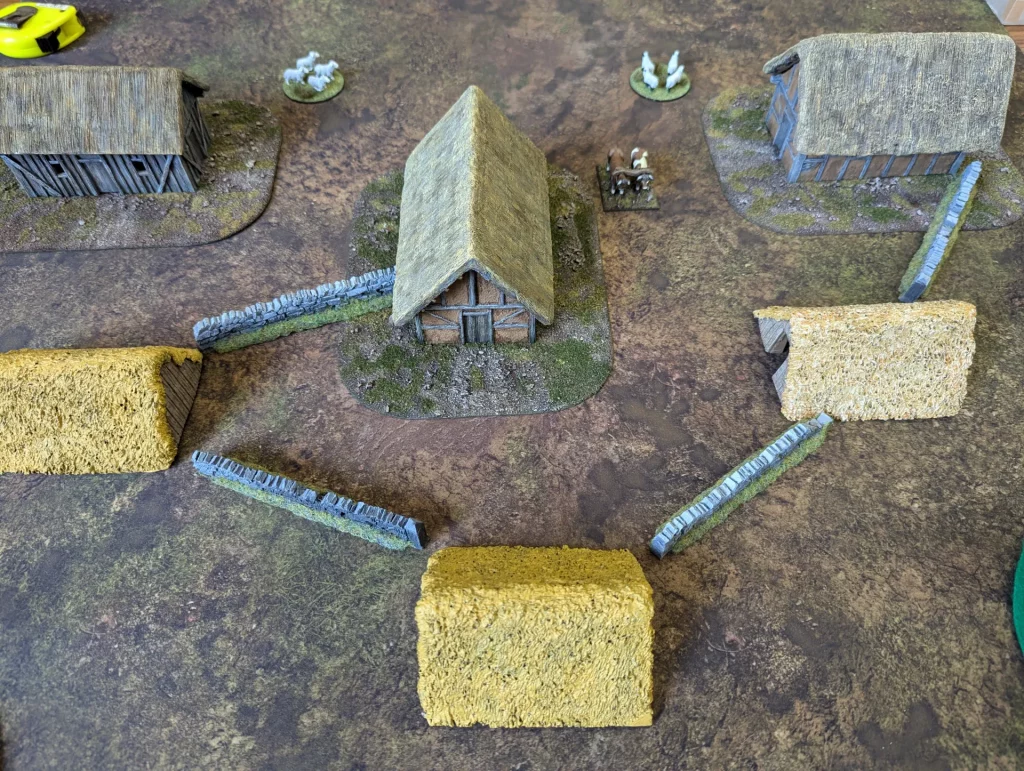
Finally, before I go into the battle itself, we noticed that the buildings we had were too small. Even my ‘large’ buildings are technically smaller than the dimensions that Saga gives for small buildings. I do have a couple of ‘even larger’ buildings but they are fragile and too cumbersome to be easily portable to take down to the club to play. Possibly we need to take a look at the club’s own collection of buildings to see if any are suitable.
Turn 1 started with the Vikings coming on to the table, and using manoeuvre and Saga abilities to get as far as they could, whilst remaining outside the L range of any civilians. I didn’t get any ‘sun’ runes, so was unable to make use of Njord to remove fatigue. I also had to be aware that I was up against the Anglo-Danes, who had the ability to give me extra fatigue. Exhausting myself to move fast was going to be a bigger risk in this game.

The alarm die was rolled, getting a 1. Then the Anglo-Danes moved, and mostly came out of the buildings to begin herding the livestock. At their end of their turn, the alarm die rolled 2, bringing them to a total of 3. Apparently everyone was still mostly asleep.
Turn two, and the Vikings moved up closer to the buildings ready to attack them next turn. The alarm roll was again low, bringing it to only 5 (7 was needed for the defenders to start bringing on troops). I was now close enough for the civilians to raise the alarm though – which they did on their turn. Two of the livestock bases were also moved off the table. The alarm was raised, bringing the total to 11. The Anglo-Dane warlord, plus units of hearthguard and warriors came onto the table.
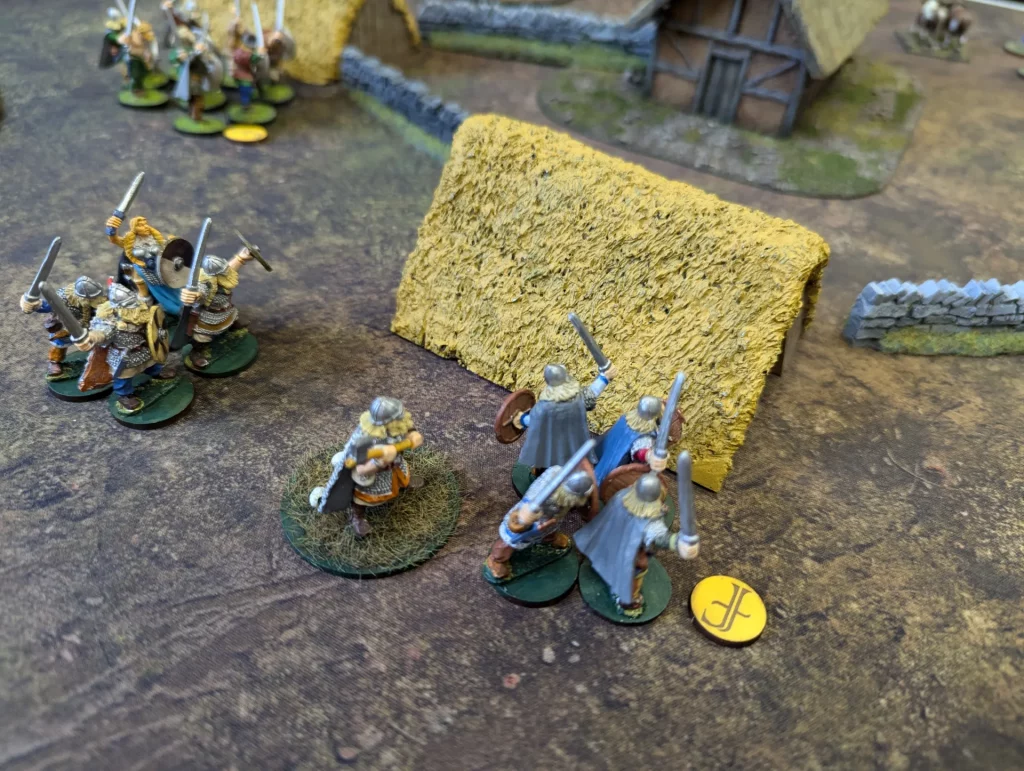
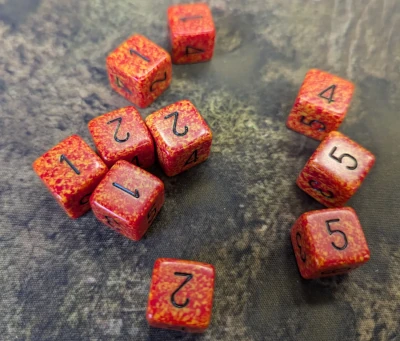
Turn 3, and the Vikings attacked the central building. It was only guarded by 4 unarmed monks, which would be no match for a unit of hardened Viking hearthguards. As in the previous game, I made use of multiple battleboard abilities to make sure I wiped them out in one go in order to be able to occupy the house. With 10 attack dice, I got 3 hits and zero kills. The only saving grace was that at least the monks didn’t kill any Vikings. I was pushed back in a moment of embarrassment.
So far this game I bad been plagued by bad dice rolls on the Saga dice, so it looked like my luck was continuing. At least the Anglo-Danes were also having bad luck on their dice, and rolled a ‘2’ again on their reinforcements, bringing the total to 13 (one short of being able to bring in another couple of units).
In their turn, the Anglo-Danes got the last unit of livestock off the table, and realised that they should probably be trying to stay in the buildings to make it harder for me to loot and burn them. So their civilians started moving back into their homes (probably against their better judgement). The warband moved up, and at the end of their turn the reinforcements total reached 18, bringing on another two units.
We still hadn’t had any combat between the warbands. The Anglo-Saxons are much faster at moving, so we’d already had some real combat by this point in the previous play through of this scenario.
Turn four, and my warriors claimed an empty house and found a box of jewels (+2 points!) putting me in the lead. We tried attacking the monks again, and this time wiped them out. I gained a lot of fatigue to move in and search the house, finding an old crone. Fortunately she didn’t kill any of my men before we finished her off. We tried to leave the building, but my opponent spent my fatigue to cancel my movement.
The Reinforcements total reached 20.

The Anglo-Danes began reclaiming the buildings, and finally their warband made contact with mine. They tried to push my warriors out of the building we had claimed, and succeeded. They killed two Viking warriors, in exchange for one of theirs. This pushed the Vikings out of the building and forced them to drop their loot. So I was back to scoring 0 points, and they now had 1 massacre point.
The alarm die brought the reinforcements total to 22.
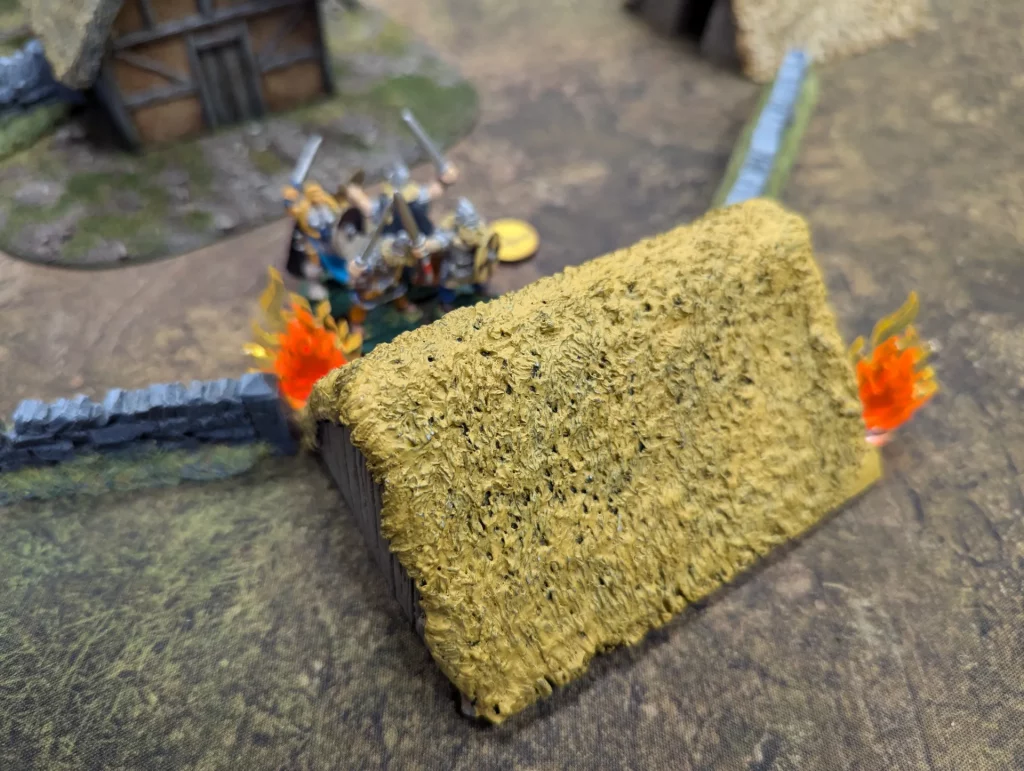
Turn 5, my Vikings left their building and burned it to the ground. This gave me two points, putting me back in the lead. However, we probably only had another turn to play. I grabbed at a third building, wiping out the civilians in there but didn’t have enough activations left to loot the building.
The Anglo-Danes rolled a 6, bringing the reinforcements total to 28. The game ends at 30, so it was now highly improbably that the Vikings would get another turn. I was one point ahead, so the Anglo-Danes just needed to kill 2 hearthguard or 4 warriors to win.
Their Warlord ran into a building, and charged out at the other end (a unit in a building is anywhere/everywhere in that building, allowing them to be used as a sort of teleport by entering at one end for a movement, then leaving from the other for a second movement). He charged my unit of hearthguard, killing two of them. I got one ‘kill’ on him, which he soaked with fatigue.
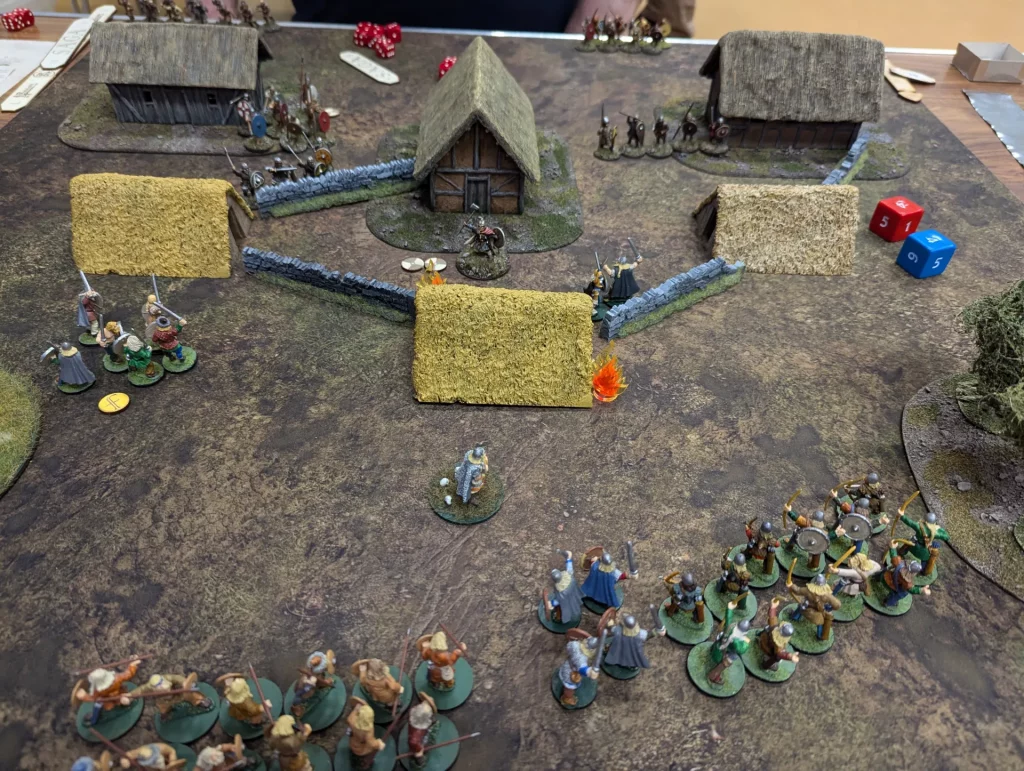
The Anglo-Dane warriors then attacked the building where my warriors were residing. He each got 3 kills on each other, so I pushed him back. However, that was more massacre points for the Danes.
This reinforcement roll needed to be a 1 for me to have any chance of claiming victory. It was a 5, bringing the total to 33 and ending the game.
So the Vikings had 2 points (for burning down a building) and the Anglo-Danes had 5 points from killing Vikings. The victory went to the Danes.
This had been a slower game than previously, but was still just as tactical. As before, I found the different victory objectives made for a more interesting game than simply trying to kill each other. Having buildings on the table, which are more than just obstacles, also adds to the fun.
Afterwards we discussed getting more buildings to try the Urban Uprising scenario (which is set in a town). It might also be interesting to try a Saga campaign, but we’d need more players for that. There is the Age of the Wolf campaign rules from first edition, plus Age of Invasions has a (I think, two player) set of campaign rules for Barbarians v Romans. Either of these would require some planning.
I also have in mind some scenarios which would require a referee. Two players where the full scenario isn’t clear at the start and where there’s possibly a third element to contend with (such as two warlords striving to find and slay some legendary beast).
Great game, thanks Sam.